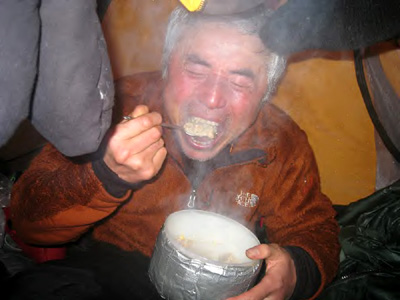16 Mar, 2008
We are walking in the mountains of Cornwallis Island pulling our sleds. Each of our sleds now weighs about 70kg. The sled itself weighs about 12 kg, and food-Pemmican is 1 kg per day. We are also carrying the tent, stove, sleeping bag, clothes, and besides those, we have digital cameras, laptops, and communicating devices such as satellite phones. The weights of food and fuel become less and less every day, but the weights for clothes, tents, ski sails, shovels, and binoculars, etc., naturally, remain the same.

Ohba eating pemmican in the tent
Since our start, we gain 15 minutes more daylight every day. The sun warms up the snow a little and makes the sled run better, and when the wind blows away the powder snow and exposes harder surfaces, that helps too. We can enjoy walking more if the sled runs well. We even get absorbed, and feel like we can walk forever. Mr. Nagatani keeps his own pace to pull a sled, so he does not sweat much. I myself have a habit to walk as fast as I can which I got from my walk to the Pole, and tend to sweat a lot. When I take off my outer layers in the tent, my fleece inters become all frosty, sticking to your body and then get wet. It is then important to adjust body heat by opening and closing the zippers.
We often see animal tracks on the snow. Some times we see holes of about 5 cm diameter in the snow, and we guess they are of lemmings. Or other times, we find other kind of tracks, but we don't have a clue. Perhaps they are of earmine's, but we have never seen it. They are round like these. 2 cm in diameter, and like man's tracks, they are left and right in turn.
 Its stride is about 5 cm. (If you are interested, Please ask our experts)
Its stride is about 5 cm. (If you are interested, Please ask our experts)We also see ravens flying. Unlike crows in Japan, they are often seen alone. It is simply amazing they survive here in over thirty below temperature.
Mitsuro Ohba
 HOME
HOME